I. Overview
Recently, I have heard that the first level cache is no longer available after Spring and MyBtis are integrated!
I wondered, why is the level one cache unavailable? Is this a bug in Spring? This aroused my great interest, because Spring is an excellent project management framework, it actually has bugs, I want to find out and satisfy my curiosity!
Two, really did not take the cache
To help me view the source code, I integrated MyBatis and Spring and wrote the following code:
AnnotationConfigApplicationContext annotationConfigApplicationContext;@Beforepublic void init(){
annotationConfigApplicationContext = new AnnotationConfigApplicationContext(AppConfig.class);
}@Testpublic void selectTest(){
TestMapper bean = annotationConfigApplicationContext.getBean(TestMapper.class);
List<User> users = bean.selectUser("周六");
System.out.println(users);
List<User> users1 = bean.selectUser("周六");
System.out.println(users == users1);
}
Copy code
To be reasonable, the above code will definitely use the first level cache in a normal environment, because it meets the first level cache hit conditions, that is, the same SqlSession, the same StatementId, the same parameters, the same paging conditions, the same query statements, and the environment The six hit rules with the same name, so theoretically, the first level cache will definitely hit! But in fact the log is as follows:
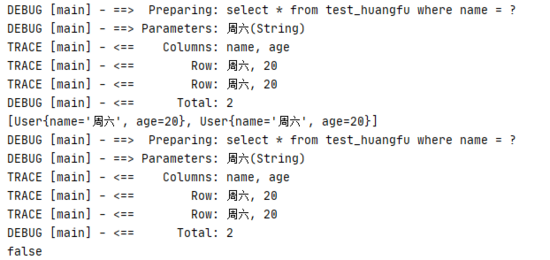
image-20200707132052562
He actually did not go to the cache, but to query the database twice, the first level cache was magnificently invalid, but why?
3. Reasons for failure
As a top-level project management framework, it is impossible for Spring to find such obvious bugs. Even if they really can't find them, it is impossible for users on github not to mention the bugs. So I interrupted the debugging and debugging and looked at the source code. That's how it works!
Where do you start? We just talked about the hit rules of the first level cache. The 2, 3, 4, 5, and 6 rules must be the same, because I just copied the query twice, and there is no change in the code, so his query statements and parameters Such conditions must be the same, so the most likely condition is the first one: The same SqlSession, can it be said that after Spring integrates MyBatis, each query uses a different SqlSession? Anyone who has read my article before should I know, I have analyzed an article about MyBatis design pattern before, and I said in the facade pattern: Every SqlSession will have a unique executor (Executor) corresponding to it, so if you want to verify whether it is the same SqlSession , It’s OK to verify whether the executor used twice is one or not, and just do it. I made a breakpoint on the BaseExecutor#query method, and the results are as follows:

image-20200707133723572
Sure enough, as I expected, the two queries did not go to an executor at all, so it must not be a SqlSession. This is only the reason, but why?
Fourth, the culprit
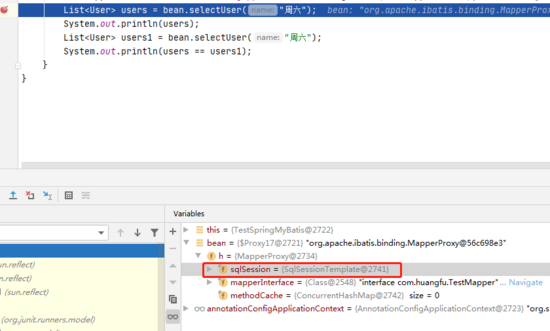
image-20200707133958314
From the breakpoints in the above figure, we can see that under normal circumstances, the DefaultSqlSession object contained in our Mapper proxy should be the DefaultSqlSession object, but after integrating Spring, we found that our SqlSession object was replaced by the SqlSessionTemplate class. We enter this class:
public class SqlSessionTemplate implements SqlSession, DisposableBean {...}
Copy code
Found that this class also inherits the SqlSession interface, it is easy to handle, then the query method must be implemented through the Select method, we enter his selectList method, look at his implementation logic:
@Overridepublic <E> List<E> selectList(String statement, Object parameter) { return this.sqlSessionProxy.selectList(statement, parameter);
}
Copy code
We found that the internal internal query of this method seems to be handed over to a layer of agents. The query operation that is actually executed by this layer of agents seems to be about to find the reason:
public SqlSessionTemplate(SqlSessionFactory sqlSessionFactory, ExecutorType executorType,
PersistenceExceptionTranslator exceptionTranslator) {
... Ignore unnecessary code... this.sqlSessionProxy = (SqlSession) newProxyInstance(SqlSessionFactory.class.getClassLoader(),
new Class[] { SqlSession.class }, new SqlSessionInterceptor());
}
Copy code
Sure enough, when this object is initialized, the proxy object is also initialized. This is achieved by the dynamic proxy of the JDK. Those familiar with dynamic proxy may know that the essence of JDK dynamic proxy is InvocationHandler. The subclass, that is, SqlSessionInterceptor, let's go inside to see its implementation:
private class SqlSessionInterceptor implements InvocationHandler { @Override
public Object invoke(Object proxy, Method method, Object[] args) throws Throwable { //获取SqlSession
SqlSession sqlSession = getSqlSession(SqlSessionTemplate.this.sqlSessionFactory,
SqlSessionTemplate.this.executorType, SqlSessionTemplate.this.exceptionTranslator); try {//Reflection calls the real processing method
Object result = method.invoke(sqlSession, args); if (!isSqlSessionTransactional(sqlSession, SqlSessionTemplate.this.sqlSessionFactory)) { //提交数据
sqlSession.commit(true);
} //Return the queried data
return result;
} catch (Throwable t) {//. . . . Ignore unnecessary code
} finally {if (sqlSession != null) {//Close the connection of SqlSession
closeSqlSession(sqlSession, SqlSessionTemplate.this.sqlSessionFactory);
}
}
}
}
Copy code
Since the SqlSession is inconsistent, it must have implemented some logic when acquiring the SqlSession, which caused the inconsistency of the SqlSession. We enter the getSqlSession method:
public static SqlSession getSqlSession(SqlSessionFactory sessionFactory, ExecutorType executorType,
PersistenceExceptionTranslator exceptionTranslator) {//...Ignore unnecessary code...
//Get the current SqlSession processor from the ThreadLocal variable
SqlSessionHolder holder =
(SqlSessionHolder)TransactionSynchronizationManager.getResource(sessionFactory); //If the transaction synchronization manager is active, get Session from SqlSessionHolder
SqlSession session = sessionHolder(executorType, holder); if (session != null) { return session;
} //If the SqlSession obtained in SqlSessionHolder is empty, create a new SqlSession
session = sessionFactory.openSession(executorType); //若事务同步管理器处于活动状态则将SqlSession设置到SqlSessionHolder中保存起来,以便下次使用
registerSessionHolder(sessionFactory, executorType, exceptionTranslator, session); return session;
}
复制代码
原来如此,原来并不是说Spring使MyBatis的一级缓存失效了,而是因为Spring只有在开启了事务之后,在同一个事务里的SqlSession会被缓存起来,同一个事务中,多次查询是可以命中缓存的!我们回到 SqlSessionInterceptor#invoke 方法里面,他在关闭的SqlSession的时候同样对 是否开启事务做了处理,我们看 closeSqlSession 方法的源码:
public static void closeSqlSession(SqlSession session, SqlSessionFactory sessionFactory) { //........忽略不必要的代码
SqlSessionHolder holder =
(SqlSessionHolder) TransactionSynchronizationManager.getResource(sessionFactory); //查看事务同步管理器是否存在 session
if ((holder != null) && (holder.getSqlSession() == session)) {
holder.released();
} else { //如果不存在就将该Session关闭掉
session.close();
}
}
复制代码
那么,既然导致一级缓存失效的罪魁祸首我们找到了,如何解决呢?
五、解决方案
为什么一级缓存失效,因为两次查询没有使用同一个事物,那么我们加上同一个事物,看看情况如何:
@Test
public void selectTest(){
TestMapper bean = annotationConfigApplicationContext.getBean(TestMapper.class); //添加事务
DataSourceTransactionManager dataSourceTransactionManager =
annotationConfigApplicationContext.getBean(DataSourceTransactionManager.class);
TransactionStatus transaction =
dataSourceTransactionManager.getTransaction(new DefaultTransactionDefinition());
List<User> users = bean.selectUser("周六");
System.out.println(users);
List<User> users1 = bean.selectUser("周六");
System.out.println(users == users1);
}
复制代码
我们这个时候来看一下结果:
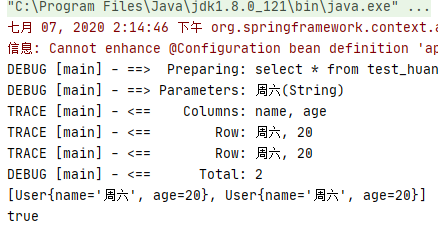
image-20200707141456766
果然不出我所料,一级缓存又被成功的使用上了。
古人云:耳听为虚,眼见为实!只有真正的经历过,才知道哪些是真,哪些是假!这一次调试源码,不光让我对Spring整合MyBatis有了一个整体的认知,更是让我对动态代理有了一个更加深入的了解,后续我会整理一下,分享出来!一、概述
最近老是听说Spring和MyBtis集成后,一级缓存就不可用了!
我就纳闷了,为什么一级缓存不可用呢?这难道是Spring的BUG?这引起了我极大的兴趣,因为Spring作为一个极其优秀的项目管理框架,它居然也有BUG,我要一探究竟,满足我的好奇心!
二、真的没走缓存
为了帮助我查看源码,我把MyBatis和Spring集成后写了如下代码:
AnnotationConfigApplicationContext annotationConfigApplicationContext;@Beforepublic void init(){
annotationConfigApplicationContext = new AnnotationConfigApplicationContext(AppConfig.class);
}@Testpublic void selectTest(){
TestMapper bean = annotationConfigApplicationContext.getBean(TestMapper.class);
List<User> users = bean.selectUser("周六");
System.out.println(users);
List<User> users1 = bean.selectUser("周六");
System.out.println(users == users1);
}
复制代码
讲道理,以上代码在常规的环境下,是一定会走一级缓存的,因为它满足一级缓存命中的条件,即同一个 SqlSession 、 StatementId 相同, 参数 相同、 分页条件 相同、 查询语句 相同、 环境名称 相同 六大命中规则,所以理论上,一级缓存是一定会命中的!但是事实上日志如下:
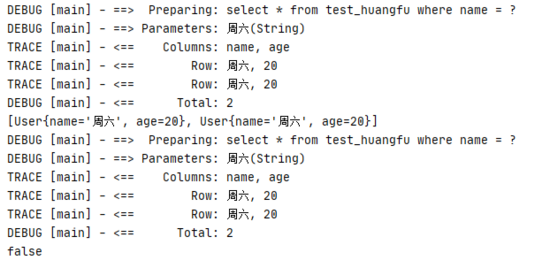
image-20200707132052562
他居然没有走缓存,而是去查询了两遍数据库,一级缓存华丽丽的的失效了,可是这道理是为什么呢?
三、失效的原因
Spring作为一个顶级项目管理框架,对于如此明显的BUG,他不可能发现不了,即使真的发现不了,那么github上使用者也不可能不提BUG,于是,我打断点调试调试,看下源码就是是如何来操作的!
从哪里下手呢?刚刚我们说过一级缓存的命中规则,2,3,4,5,6条规则一定是一样的,因为我只是单纯的复制了两遍查询,代码上没有变动,所以他的查询语句、参数之类的条件一定是相同的,那么最可能出现的条件就是第一条: 同一个SqlSession ,难道说Spring集成MyBatis后,每一次查询都是用了不同的SqlSession? 以前看过我文章的都应该知道,我之前分析过一篇关于MyBatis设计模式的文章,关于门面模式中说到过: 每一个SqlSession都会有一个唯一的执行器(Executor)与之对应 ,所以说如果想验证是不是同一个SqlSession,只需要验证两次使用的执行器是不是一个就OK了,说做就做,我在 BaseExecutor#query 方法上断点,结果如下:

image-20200707133723572
果然不出我所料,两次查询走的根本不是一个执行器,那么也就一定不是一个SqlSession,这下只掉原因了,但是为什么呢?
四、罪魁祸首
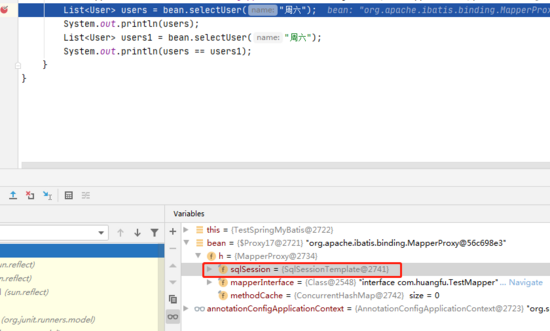
image-20200707133958314
通过上图的断点我们可以看出来,正常情况下,我们的Mapper代理里面所包含的应该是 DefaultSqlSession 对象,但是通过整合Spring后我们发现,我们的SqlSession对象被偷梁换柱了,换成了 SqlSessionTemplate 类,我们进入到这个类中:
public class SqlSessionTemplate implements SqlSession, DisposableBean {...}
复制代码
发现这个类也继承了 SqlSession 接口,那就好办了,那么查询的方法一定是经过Select方法来实现的,我们进入到他的 selectList 方法,看下他的实现逻辑:
@Overridepublic <E> List<E> selectList(String statement, Object parameter) { return this.sqlSessionProxy.selectList(statement, parameter);
}
复制代码
我们发现,这个方法内部内部的查询似乎又交给了一层代理,由这一层代理去真正执行的查询操作,我们似乎快找到原因了:
public SqlSessionTemplate(SqlSessionFactory sqlSessionFactory, ExecutorType executorType,
PersistenceExceptionTranslator exceptionTranslator) {
... 忽略不必要的代码... this.sqlSessionProxy = (SqlSession) newProxyInstance(SqlSessionFactory.class.getClassLoader(),
new Class[] { SqlSession.class }, new SqlSessionInterceptor());
}
复制代码
果不其然,这个对象在初始化的时候,将这个代理对象也连带着初始化了,这个正是使用的JDK的动态代理来实现的,熟悉动态代理的同学可能会知道,JDK动态代理的精髓也就是 InvocationHandler 的子类,也就是 SqlSessionInterceptor ,我们进入到里面看一下他的实现:
private class SqlSessionInterceptor implements InvocationHandler { @Override
public Object invoke(Object proxy, Method method, Object[] args) throws Throwable { //获取SqlSession
SqlSession sqlSession = getSqlSession(SqlSessionTemplate.this.sqlSessionFactory,
SqlSessionTemplate.this.executorType, SqlSessionTemplate.this.exceptionTranslator); try { //反射调用真正的处理方法
Object result = method.invoke(sqlSession, args); if (!isSqlSessionTransactional(sqlSession, SqlSessionTemplate.this.sqlSessionFactory)) { //提交数据
sqlSession.commit(true);
} //返回查询的数据
return result;
} catch (Throwable t) { //。。。。忽略不必要代码
} finally { if (sqlSession != null) { //关闭SqlSession的连接
closeSqlSession(sqlSession, SqlSessionTemplate.this.sqlSessionFactory);
}
}
}
}
复制代码
既然SqlSession不一致,那么肯定是在获取SqlSession的时候,里面实现了一些逻辑,从而造成了 SqlSession的不一致,我们进入到 getSqlSession 方法中:
public static SqlSession getSqlSession(SqlSessionFactory sessionFactory, ExecutorType executorType,
PersistenceExceptionTranslator exceptionTranslator) { //...忽略不必要代码....
//从ThreadLocal变量里面获取当前的SqlSession的处理器
SqlSessionHolder holder =
(SqlSessionHolder)TransactionSynchronizationManager.getResource(sessionFactory); //如果事务同步管理器处于活动状态则从SqlSessionHolder获取Session
SqlSession session = sessionHolder(executorType, holder); if (session != null) { return session;
} //如果SqlSessionHolder中获取的SqlSession为空,则新建一个SqlSession
session = sessionFactory.openSession(executorType); //若事务同步管理器处于活动状态则将SqlSession设置到SqlSessionHolder中保存起来,以便下次使用
registerSessionHolder(sessionFactory, executorType, exceptionTranslator, session); return session;
}
复制代码
原来如此,原来并不是说Spring使MyBatis的一级缓存失效了,而是因为Spring只有在开启了事务之后,在同一个事务里的SqlSession会被缓存起来,同一个事务中,多次查询是可以命中缓存的!我们回到 SqlSessionInterceptor#invoke 方法里面,他在关闭的SqlSession的时候同样对 是否开启事务做了处理,我们看 closeSqlSession 方法的源码:
public static void closeSqlSession(SqlSession session, SqlSessionFactory sessionFactory) { //........忽略不必要的代码
SqlSessionHolder holder =
(SqlSessionHolder) TransactionSynchronizationManager.getResource(sessionFactory); //查看事务同步管理器是否存在 session
if ((holder != null) && (holder.getSqlSession() == session)) {
holder.released();
} else { //如果不存在就将该Session关闭掉
session.close();
}
}
复制代码
那么,既然导致一级缓存失效的罪魁祸首我们找到了,如何解决呢?
五、解决方案
为什么一级缓存失效,因为两次查询没有使用同一个事物,那么我们加上同一个事物,看看情况如何:
@Test
public void selectTest(){
TestMapper bean = annotationConfigApplicationContext.getBean(TestMapper.class); //添加事务
DataSourceTransactionManager dataSourceTransactionManager =
annotationConfigApplicationContext.getBean(DataSourceTransactionManager.class);
TransactionStatus transaction =
dataSourceTransactionManager.getTransaction(new DefaultTransactionDefinition());
List<User> users = bean.selectUser("周六");
System.out.println(users);
List<User> users1 = bean.selectUser("周六");
System.out.println(users == users1);
}
复制代码
我们这个时候来看一下结果:
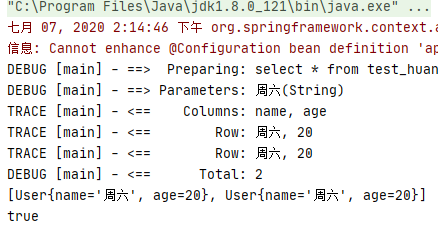
image-20200707141456766
As expected, the first level cache was successfully used again.
The ancients said: Hearing is fictitious, seeing is believing! Only after the real experience can we know which are true and which are false! This time debugging the source code not only gave me an overall understanding of Spring's integration of MyBatis, but also gave me a deeper understanding of dynamic agents. I will sort it out and share it later!
[Disclaimer: The pictures and text information in this article are all reprinted from the Internet by Qianfeng Chongqing Java Training Editor. They are intended to be shared and read. The copyright belongs to the original author. If there is any infringement, please contact us to delete. 】